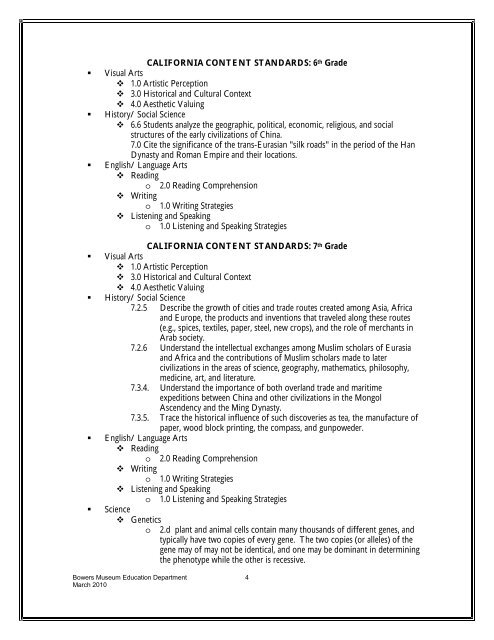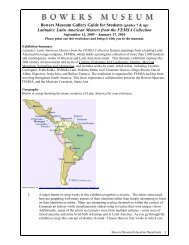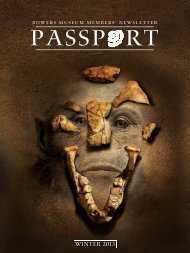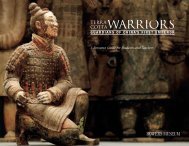Secrets of the Silk Road – Teacher Packet - Bowers Museum
Secrets of the Silk Road – Teacher Packet - Bowers Museum
Secrets of the Silk Road – Teacher Packet - Bowers Museum
Create successful ePaper yourself
Turn your PDF publications into a flip-book with our unique Google optimized e-Paper software.
CALIFORNIA CONTENT STANDARDS: 6th Grade<br />
Visual Arts<br />
1.0 Artistic Perception<br />
3.0 Historical and Cultural Context<br />
4.0 Aes<strong>the</strong>tic Valuing<br />
History/ Social Science<br />
6.6 Students analyze <strong>the</strong> geographic, political, economic, religious, and social<br />
structures <strong>of</strong> <strong>the</strong> early civilizations <strong>of</strong> China.<br />
7.0 Cite <strong>the</strong> significance <strong>of</strong> <strong>the</strong> trans-Eurasian "silk roads" in <strong>the</strong> period <strong>of</strong> <strong>the</strong> Han<br />
Dynasty and Roman Empire and <strong>the</strong>ir locations.<br />
English/ Language Arts<br />
Reading<br />
o 2.0 Reading Comprehension<br />
Writing<br />
o 1.0 Writing Strategies<br />
Listening and Speaking<br />
o 1.0 Listening and Speaking Strategies<br />
CALIFORNIA CONTENT STANDARDS: 7th Grade<br />
Visual Arts<br />
1.0 Artistic Perception<br />
3.0 Historical and Cultural Context<br />
4.0 Aes<strong>the</strong>tic Valuing<br />
History/ Social Science<br />
7.2.5 Describe <strong>the</strong> growth <strong>of</strong> cities and trade routes created among Asia, Africa<br />
and Europe, <strong>the</strong> products and inventions that traveled along <strong>the</strong>se routes<br />
(e.g., spices, textiles, paper, steel, new crops), and <strong>the</strong> role <strong>of</strong> merchants in<br />
Arab society.<br />
7.2.6 Understand <strong>the</strong> intellectual exchanges among Muslim scholars <strong>of</strong> Eurasia<br />
and Africa and <strong>the</strong> contributions <strong>of</strong> Muslim scholars made to later<br />
civilizations in <strong>the</strong> areas <strong>of</strong> science, geography, ma<strong>the</strong>matics, philosophy,<br />
medicine, art, and literature.<br />
7.3.4. Understand <strong>the</strong> importance <strong>of</strong> both overland trade and maritime<br />
expeditions between China and o<strong>the</strong>r civilizations in <strong>the</strong> Mongol<br />
Ascendency and <strong>the</strong> Ming Dynasty.<br />
7.3.5. Trace <strong>the</strong> historical influence <strong>of</strong> such discoveries as tea, <strong>the</strong> manufacture <strong>of</strong><br />
paper, wood block printing, <strong>the</strong> compass, and gunpoweder.<br />
English/ Language Arts<br />
Reading<br />
o 2.0 Reading Comprehension<br />
Writing<br />
o 1.0 Writing Strategies<br />
Listening and Speaking<br />
o 1.0 Listening and Speaking Strategies<br />
Science<br />
Genetics<br />
o 2.d plant and animal cells contain many thousands <strong>of</strong> different genes, and<br />
typically have two copies <strong>of</strong> every gene. The two copies (or alleles) <strong>of</strong> <strong>the</strong><br />
gene may <strong>of</strong> may not be identical, and one may be dominant in determining<br />
<strong>the</strong> phenotype while <strong>the</strong> o<strong>the</strong>r is recessive.<br />
<strong>Bowers</strong> <strong>Museum</strong> Education Department<br />
March 2010<br />
4





